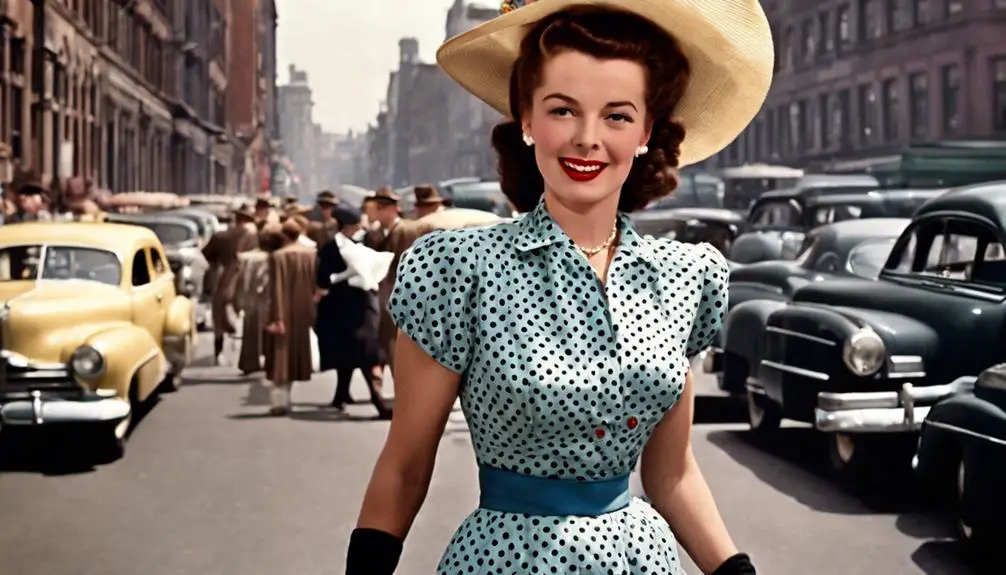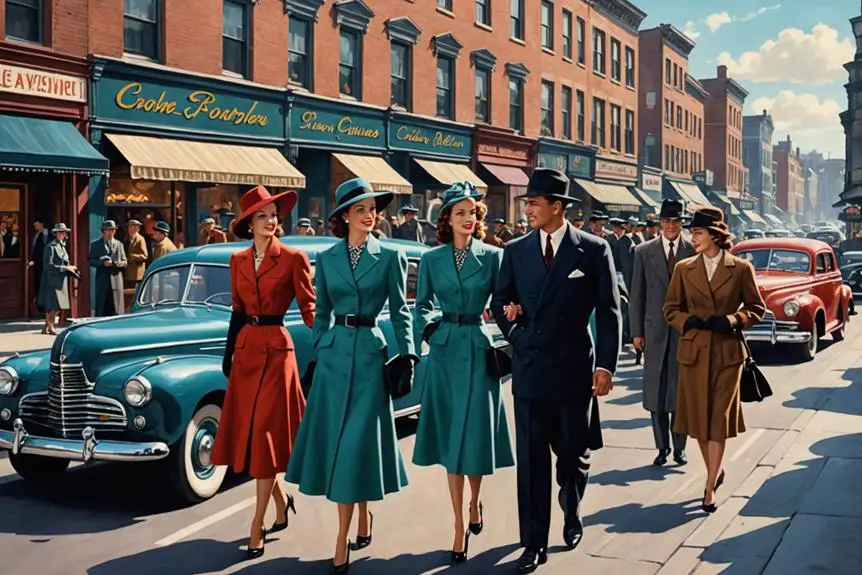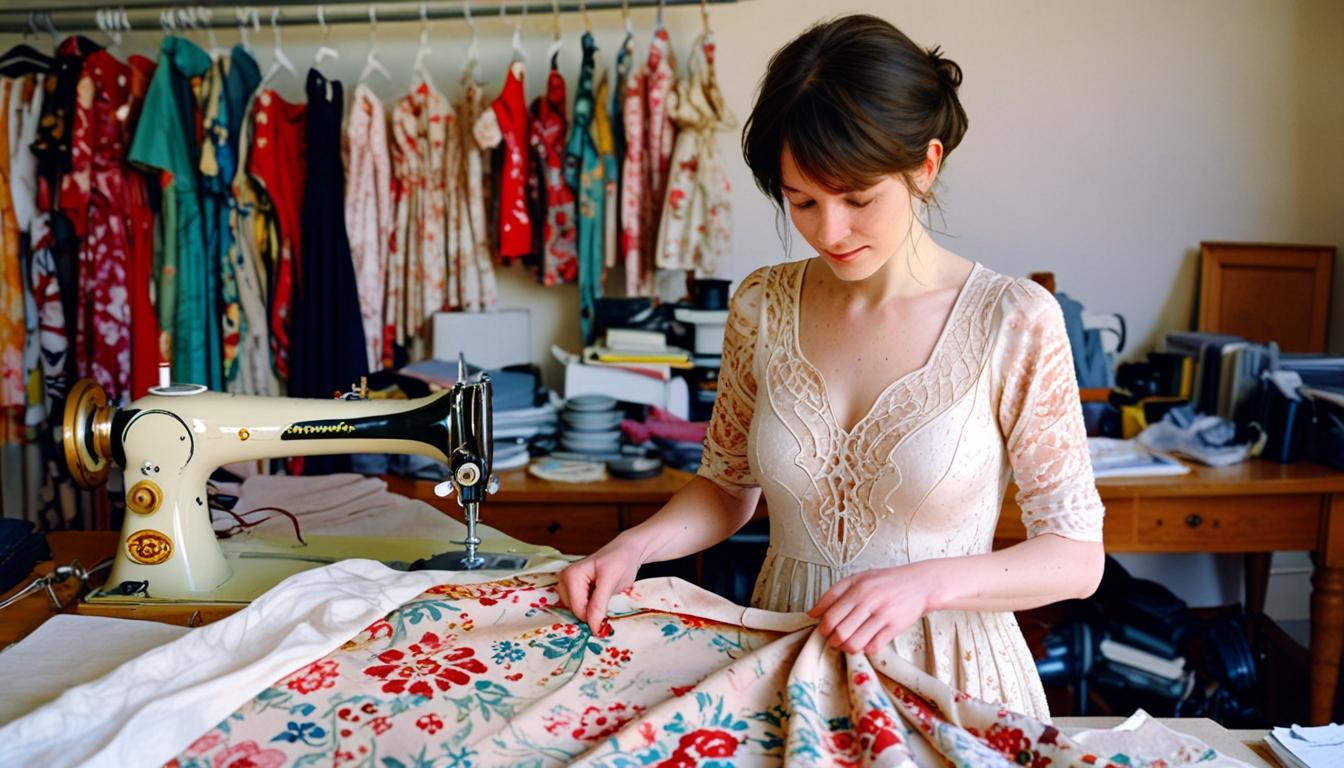You'll find that late 1940s fashion trends ushered in a delightful blend of elegance and individuality. Iconic designer Christian Dior's "New Look" revolutionized women's attire with its voluminous skirts and fitted bodices, celebrating femininity after the war. Men, too, embraced looser suits and bold styles featuring vibrant colors and wider lapels. Children's fashion echoed adult trends, merging practicality with fun designs. Accessories like pillbox hats and bamboo-handled bags added flair to outfits. Cultural influences, including Hollywood glitz, shaped everyday styles, reflecting a society keen for change and expression. There's much more to discover about this fascinating fashion decade!
Women's Fashion Highlights

Reviving femininity, late 1940s women's fashion brought a fresh elegance to post-war wardrobes. This era marked a significant departure from the wartime austerity that had dominated previous years. With Christian Dior's groundbreaking "New Look" collection in 1947, you saw the introduction of voluminous skirts that flowed gracefully from the waist, reaching mid-calf to ankle length. These dresses and skirts not only celebrated the female form but also offered a stunning contrast to the practicality of wartime clothing.
Tailored suits became a staple, featuring nipped-in waists and sculpted shoulders that accentuated your figure. Shirtwaist dresses with contrasting collars and luxurious evening gowns adorned with embellishments showcased the significance of elegance in women's fashion. It wasn't just about the clothes, though; accessories played a crucial role in completing your look. You'd often see wrist-length gloves, stylish hats, and elegant handbags that reflected the era's attention to detail.
While formal styles flourished, this period also embraced casual styles, allowing for comfortable day dresses and trousers to gain acceptance in women's wardrobes. The blend of tailored sophistication with relaxed chic made it easy for you to shift from day to night.
Men's Style Evolution
As the late 1940s unfolded, men's fashion underwent a revitalizing transformation that mirrored the era's newfound optimism. With the end of World War II, men began to embrace a more relaxed style that reflected their return to civilian life. The shift towards looser suits featured pronounced shoulders and cuffed pants, moving away from the rigid silhouettes of wartime.
Additionally, this period saw an appreciation for individuality, as men began to experiment with unique styles, including tailored vintage looks, allowing them to showcase their personality through clothing.
The "Bold Look" emerged during this time, characterized by wider lapels, vibrant colors, and patterned fabrics. This style contrasted sharply with the muted tones of the past, signaling a fresh start. Casual attire also gained popularity, with men sporting Hawaiian shirts and wide-leg trousers. Among the favored choices was the Victory Suit, which boasted a single-breasted design and less stringent fabric restrictions, perfectly embodying post-war optimism.
You might notice some key elements defining this period:
- Looser suits with pronounced shoulders
- Wider lapels and vibrant colors in the Bold Look
- Acceptance of casual styles like Hawaiian shirts
- Evolution of accessories, with flat caps replacing formal hats
Accessories also evolved, as men began to favor more casual headwear like flat caps, suitable for leisure activities.
This era marked a significant style evolution, allowing men to express their individuality and embrace a newfound freedom. With each piece, they crafted a look that celebrated the joy of returning to normalcy after the war, making late 1940s men's fashion a distinct chapter in style history.
Children's Fashion Trends

Children's fashion in the late 1940s embraced a delightful blend of practicality and style, echoing adult trends while catering to the needs of young wearers. This period saw the introduction of utility clothing, which cleverly used ration coupons to create practical yet stylish garments.
Boys often sported hand-knitted sweaters, blazers, and high-waisted shorts, while girls dazzled in cotton dresses adorned with charming Peter Pan collars and puffed sleeves.
One of the standout features of girls' dresses was the use of smocking on bodices, a decorative element that added a touch of elegance to the otherwise functional utility fashion.
As the post-war years rolled on, brighter colors and playful styles began to emerge, signaling a shift toward more casual and fun clothing for children. The shift from somber hues to vibrant patterns reflected the optimism of the era, inviting kids to express their personalities through fashion.
The Hollywood influence also played a significant role in shaping children's fashion. Movies and celebrities inspired trends, leading to the popularity of stylish elements like high-waisted shorts and fashionable accessories.
It was a time when children couldn't only dress practically but also embrace the glamour and style seen on screen.
Iconic Accessories of the Era
Embracing the vibrant style of the late 1940s, iconic accessories played an essential role in defining the decade's fashion landscape. This period was all about innovative accessory designs that reflected both practicality and resourcefulness, catering to the needs of women post-war.
You'd find fashionistas sporting a variety of eye-catching items that transformed their ensembles.
Some of the standout accessories included:
- Bamboo-handled bags: Designed by Guccio Gucci, these bags became a fashionable statement piece.
- Pillbox hats and turbans: These smaller hats not only added charm but also served as chic solutions for completing outfits.
- Snoods and headscarves: Scarcity of traditional fabrics prompted creative designs, perfect for managing hair while maintaining style.
- Rounded-toe shoes: Made from alternative materials, these shoes epitomized the era's focus on comfort and practicality.
The introduction of the bikini in 1946 by designers Jacques Heim and Louis Réard marked a cultural shift, although it stirred some controversy.
Accessories in this era were about more than just looks; they were functional, reflecting the resourcefulness of women as they adapted to changing times.
Whether you were dressing up with a stylish hat or grabbing your bamboo-handled bag for a day out, these accessories were essential to the late 1940s wardrobe, beautifully merging fashion with the realities of life.
Cultural Influences on Fashion

The late 1940s wasn't just about eye-catching accessories; it was a period where cultural influences shaped fashion in profound ways. After the war, people were enthusiastic to embrace a new style that reflected both optimism and femininity.
Christian Dior's 1947 New Look became a symbol of this change, celebrating luxurious fabrics, cinched waists, and full skirts that made women feel beautiful and confident. This shift was a stark contrast to the utilitarian styles worn during wartime. Much like the evolution of the Chuck Taylor All Star, which adapted to cultural shifts over the decades, fashion in this era mirrored societal changes.
Hollywood played a significant role in driving these fashion trends. Actresses like Rita Hayworth and Ingrid Bergman dazzled audiences with their glamorous looks, influencing everyday women's fashion. Everyone wanted to emulate the starlet's elegance, further pushing the boundaries of what was considered stylish.
At the same time, the zoot suit trend emerged, particularly in minority communities. This bold fashion statement wasn't just about style; it represented cultural assertiveness during a time of racial tensions. The zoot suit riots of 1943 highlighted the struggles for identity and acceptance during the post-war era.
Paris fashion also made a comeback, with the Th\u00eâtres de la Mode show in 1945 marking the resilience of French couturiers. This event reaffirmed Paris as the fashion capital, showcasing innovative designs that inspired many.
Together, these influences created a dynamic landscape for fashion, where expressions of individuality and cultural pride flourished amidst a changing world.




